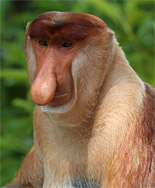Get
To Know
|
 The
Proboscis Monkey or long nosed monkey is a reddish brown arboreal
Old World monkey that is endemic to the southeast Asian island of
Borneo. They also go by the Malay name monyet belanda (Dutch monkey)
as Indonesians remarked that the Dutch colonisers often had similarly
large bellies and noses. Males have a maximum known weight of 30
kg while Females weigh 7 to 12 kg, with a maximum known mass of
15 kg. The large nose of the male can exceed 10.2 cm in length and
hangs lower than the mouth. They live most commonly in coastal areas
and along rivers. They favour dipterocarp, mangrove and riverine
forests. It is perhaps the most aquatic of the primates and is a
fairly good swimmer, capable of swimming up to 20 m underwater and
have been known to swim across rivers. They have a long coat; the
fur on the back is bright orange, reddish brown, yellowish brown
or brick-red. Their face is orange-pink and the male has a red penis
with a black scrotum. Both sexes have bulging stomachs that give
the monkeys what resembles a pot belly and many of the monkeys'
toes are webbed. Females become sexually mature at five years old
and copulations tend to last for half a minute with both sexes participating
although now always successfully. Perhaps this is because the male
will grab the female by the ankles or torso and mount her from behind.
It likely doesn't help that when soliciting sexual attention, both
sexes will pouted, the males will sometimes vocalize, the females
will present their backsides, and mating pairs are sometimes harassed
by subadults. Proboscis monkeys eat primarily fruit and leaves,
but will also eat flowers, seeds and insects to a lesser extent.
Their daily activities consist of resting, traveling, feeding and
keeping vigilant. As night approaches, the monkeys move back near
the river and forage again. The proboscis monkey is assessed as
Endangered and its total population has decreased by more than 50%
in the past 36-40 years to 2008 due to ongoing habitat loss and
hunting in some areas. The largest remaining populations are found
in Kalimantan; there are far fewer in Sarawak, Brunei and Sabah. The
Proboscis Monkey or long nosed monkey is a reddish brown arboreal
Old World monkey that is endemic to the southeast Asian island of
Borneo. They also go by the Malay name monyet belanda (Dutch monkey)
as Indonesians remarked that the Dutch colonisers often had similarly
large bellies and noses. Males have a maximum known weight of 30
kg while Females weigh 7 to 12 kg, with a maximum known mass of
15 kg. The large nose of the male can exceed 10.2 cm in length and
hangs lower than the mouth. They live most commonly in coastal areas
and along rivers. They favour dipterocarp, mangrove and riverine
forests. It is perhaps the most aquatic of the primates and is a
fairly good swimmer, capable of swimming up to 20 m underwater and
have been known to swim across rivers. They have a long coat; the
fur on the back is bright orange, reddish brown, yellowish brown
or brick-red. Their face is orange-pink and the male has a red penis
with a black scrotum. Both sexes have bulging stomachs that give
the monkeys what resembles a pot belly and many of the monkeys'
toes are webbed. Females become sexually mature at five years old
and copulations tend to last for half a minute with both sexes participating
although now always successfully. Perhaps this is because the male
will grab the female by the ankles or torso and mount her from behind.
It likely doesn't help that when soliciting sexual attention, both
sexes will pouted, the males will sometimes vocalize, the females
will present their backsides, and mating pairs are sometimes harassed
by subadults. Proboscis monkeys eat primarily fruit and leaves,
but will also eat flowers, seeds and insects to a lesser extent.
Their daily activities consist of resting, traveling, feeding and
keeping vigilant. As night approaches, the monkeys move back near
the river and forage again. The proboscis monkey is assessed as
Endangered and its total population has decreased by more than 50%
in the past 36-40 years to 2008 due to ongoing habitat loss and
hunting in some areas. The largest remaining populations are found
in Kalimantan; there are far fewer in Sarawak, Brunei and Sabah.
|
|
|
|
A Pilgrim's Progress
by
John Grey
So Billy sees the south side
for the first time in his life
and doesn't realize
there is such poverty.
"You mean there's folks
who've never sipped
a Starbucks latte?" he asks.
He's been like a pilgrim
setting foot in Plymouth.
His only regret is
he didn't bring along
an extra electric toothbrush
to impress the natives.
Burnt-out tenements,
trash-strewn parks,
gang tags on every wall,
it's a new world all right.
Too bad he didn't have more time
to preach the gospel
but he had to find an ATM.
Put your card in,
type in a pin number,
take the money out...
hallelujah!
You're on the north side.
John Grey is an Australian poet, US resident. Recently
published in New Plains Review, Rockhurst Review and Spindrift
with work upcoming in South Carolina Review, Gargoyle, Sanskrit
and Louisiana Literature.
|
 The
Proboscis Monkey - Issue Twenty-Two
The
Proboscis Monkey - Issue Twenty-Two